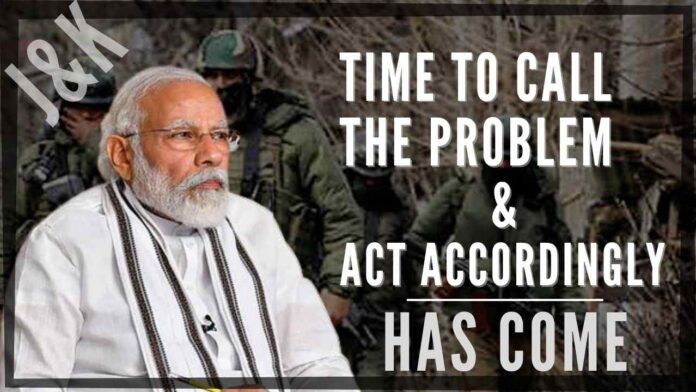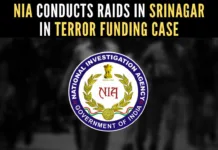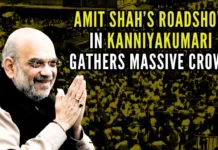
Enemies both within and outside continue to disturb peace in strategic border state & Kashmir Valley
Notwithstanding some result-oriented steps being taken by the powers-that-be at the Centre and in the state after the abrogation of seditious Article 370 and discriminatory Article 35A, terrorists, both local and foreigner, continue to bloody and convulse the social and political scene of the sensitive and strategic border state in general and Kashmir Valley in particular. October 2021 alone witnessed the martyrdom of 12 armed forces personnel, including two JCOs, and brutal murders of 13 innocent civilians, including a Sikh female principal and five non-local labourers[1][2]. 19 terrorists were also liquidated by the security forces. The targeted killings of non-Muslims triggered the migration of the original inhabitants of Kashmir, Hindus, and non-locals from Kashmir. Reports suggest that “around 10,000 of them quit Kashmir within the first two weeks of (gruesome) killings” and “over 350 Kashmiri Hindu families left Kashmir in the same period”[1].
Why has the Indian state failed to eradicate the cult of terror in J&K, motivate over 5 lakh Hindus, who migrated to Jammu and other places in January 1990, to return to Kashmir, and establish the authority of the state in the real sense of the term? The reasons are not really difficult to fathom. The most important being the failure of the authorities at the Centre to call the problem in Kashmir by name and tackle it accordingly, as also its inability to rein in the Valley-based ruling elite known for its very friendly attitude towards the hostile nations and terrorists and separatists of all varieties and the manner in which the supporters and promoters of radical Islamists in the establishment helped them muddy Indian waters and disturb the state’s sensitive socio-religious and political equilibrium.
One can catalogue here umpteen instances to establish that while New Delhi consistently dithered; empowered and promoted the subversive ruling elite; and failed to rein in that section of bureaucracy which willfully violated the service rules to tarnish the country’s image in the eyes of the international community, the governing class in Kashmir left no stone unturned to allow the situation to deteriorate and communalize and create an impression in the Valley that the Indian presence in J&K was illegal, unconstitutional and against the will of the constituencies it represented and continues to, represent.
A reference to just four or five instances in this regard would be in order. One, many, who were involved in bomb blasts, including the ones in Baramulla in the 70s, instead of being punished, were rewarded. Some became even ministers. Two, the Kashmiri ruling elite accorded kid-glove treatment to the traitors, conspirators, murderers, and Pak agents. The Home and Law Departments hardly acted against them. Three, the rulers in Kashmir would openly ask their cadres to go to Pakistan to get arms training against India[3]; they would misuse the floor of the assembly to tell their constituencies that “J&K has only acceded to India, and not merged with India”; they would invariably visit the houses of the slain terrorists to express their solidarity with their cause and their families, and they virtually converted the assembly into a den of anti-India intrigues. Instead of producing a moral effect, the ruling elite would accord a VVIP treatment to terrorists, separatists, and murderers in Kashmir jails, especially Central Jail Srinagar. The ruling elite would invoke TADA, PSA, and similar other laws on occasions but only to divert the attention from the real issue and hoodwink the nation and the authorities in New Delhi. Such had been the attitude of the Kashmiri ruling elite. Four, no action was taken against top-ranking bureaucrats, including Naeem Akhtar, MA Khan, Ashok Jaitley, ML Koul, B R Singh, Sushma Chowdhary, Abdul Rashid Mubaraki, Abdul Hamid Mattoo, and Abdul Salam Bhat, who in early 1990 petitioned the United Nations against what they called a violation of human rights in Kashmir. The then J&K Governor G C Saxena did suspend Akhtar, Khan, Bhat, Mubaraki, and Mattoo but reinstated them 80 days later. Sadly, some of the petitioners rose to the position of Chief Secretary (Ashok Jaitley) and Cabinet Minister (Naeem Akhtar) And, five, New Delhi consistently refused to recognize the gravity of the situation in Kashmir and put all eggs in the baskets of the Kashmiri ruling elite which was dangerous than the known terrorists, subversives and Pakistani moles as it had been subverting the polity from within in a most brazen manner and not allowing the institutions to act against the forces inimical to India and the minorities, including the minuscule minority of Hindus and Sikhs in Kashmir.
Things did remain under control between August 4, 2019, and August 13, 2020, when almost all those responsible for the rise of separatism and terrorism were either behind the bars or under house arrest[4]. It was hoped that things would further improve. But, sadly, it was not to be. The authorities dumbfounded the nation in August 2020 by setting free almost all those who constituted Kashmir’s ruling elite and the results are as they are. The Abdullahs, the Muftis, the Lones, the Sozs, the Mirs, the Bukhari’s, and the ilk are again indulging in activities they used to indulge in before August 4, 2019. No wonder then that the situation is worsening in Kashmir with each passing moment and that the concerned Indians have started questioning New Delhi’s policy towards the cult of terror in Kashmir and the so-called mainstream Kashmiri leaders. Their concerns just can’t be dismissed as preposterous and silly.
Now that the things in Kashmir and parts of Jammu province have virtually gone out of hand, it’s time to review the whole anti-terror and anti-separatist policy. To mark time would be only to further damage the nation’s cause in J&K and help the enemies both within and outside. The nation just can’t afford the rise of such a situation.
What, then, could be the way out?
The way out is to pursue the model of late Siddhartha Shankar Ray and KPS Gill to eradicate the menace of terrorism. Ray as Bengal CM crushed the Naxal terrorism and it’s considered his splendid achievement[5]. It bears recalling the dreaded Naxalites had held the entire state of WB and its people to “ransom”. In the 70s, the Bengal Government had to order “police action when they were easily succumbing to the Naxalites; arms were being looted but they were hardly countering (the offensive); the Naxalites were even killing traffic policemen; not only were traffic policemen given arms, they were ordered to chain the guns to their bodies to prevent looting; there was complete anarchy”. It was under these circumstances that “the Ray dispensation had to give a slogan ‘Live and Let Live’ (banchoon ebang banchte din) in Bengali”[5]. The Bengal police had been told three things to eliminate Naxal terror: “follow the Constitution to act, don’t see any political colour while you act and, finally, do not succumb meekly while you have a gun in your hand because you may be killed otherwise”. The policy produced the desired results.
Similarly, in Punjab, the top cop, KPS Gill, eradicated the Khalistani terror with a heavy hand[7]. His spectacular success was the “Operation Black Thunder”, which freed Golden Temple from the terrorists. Not just that, he saw to it that the Gurudwaras were not used or misused by terrorists. The fact of the matter is that he was “not concerned with winning hearts and minds, which was and still the classical method of ending terrorism, as opposed to the ideological form”.
According to Punjab-watchers, “there should be no doubt that while Gill did not finish off Punjab terrorism single-handedly, the winning strategy was his. And it came from his mind, rather than the force he commanded. Because he was able to take the demoralized Punjab Police force, gave it that crucial aggression and direction, and eventually took care of the kharkus, as Sikh militants of the time were called. He had never formally studied counter-insurgency but was a well-read and educated person with an enormous sense of certitude, and he successfully transmitted this to his force making him the great leader that he was…Faced with the 1992 elections, he decided, more or less by himself, that we’d get a platoon of police to secure each and every candidate. It was a preposterous idea – but that preposterous idea was implemented, and the end result was we didn’t lose a single candidate”.
It is hoped that PM Narendra Modi and HM Amit Shah would call the problem in Kashmir by name, appreciate the methodology Ray and Gill used to eradicate Naxal and Khalistani terror, and direct the J&K administration to pursue the Ray and Gill model to eradicate the cult of terror in J&K. The problem in Kashmir is Islamic jihad and it’s 682-year-old.
Note:
1. Text in Blue points to additional data on the topic.
2. The views expressed here are those of the author and do not necessarily represent or reflect the views of PGurus.
References:
[1] October turns out to be deadliest month in Jammu and Kashmir this year with 44 killings – Nov 01, 2021,, ET
[2] In Kashmir, non-local labourers choose life over livelihood as militants warn of dire consequences – Oct 18, 2021, First Post
[3] In Syed Ali Shah Geelani’s death, Pakistan Has Lost Its Last Man Standing in Kashmir – Sep 04, 2021, News 18
[4] Terrorist incidents have declined in Kashmir since Aug 5, 2019: Shah – Oct 24, 2021, Business Standard
[5] Terrorism doesn’t die suddenly: Siddhartha Shankar Ray – Jul 13, 1987, India Today
[6] To eradicate terror in J&K, pursue ‘Ray and Gill’ model – Nov 03, 2021, Koshur Samachar
[7] KPS Gill (1934-2017): The man who finished Khalistani terrorism in Punjab – May 27, 2017, Scroll
PGurus is now on Telegram. Click here to join our channel and stay updated with all the latest news and views
For all the latest updates, download PGurus App.
- ‘Kashmir My core constituency’: Revisiting July 12, 2003 to understand politics, Omar Abdullah-style - March 15, 2024
- Total deviation from traditional approach: Seven takeaways from PM Modi’s March 7 Srinagar visit - March 9, 2024
- Status of political parties: Why is further J&K reorganization imperative? - March 1, 2024










